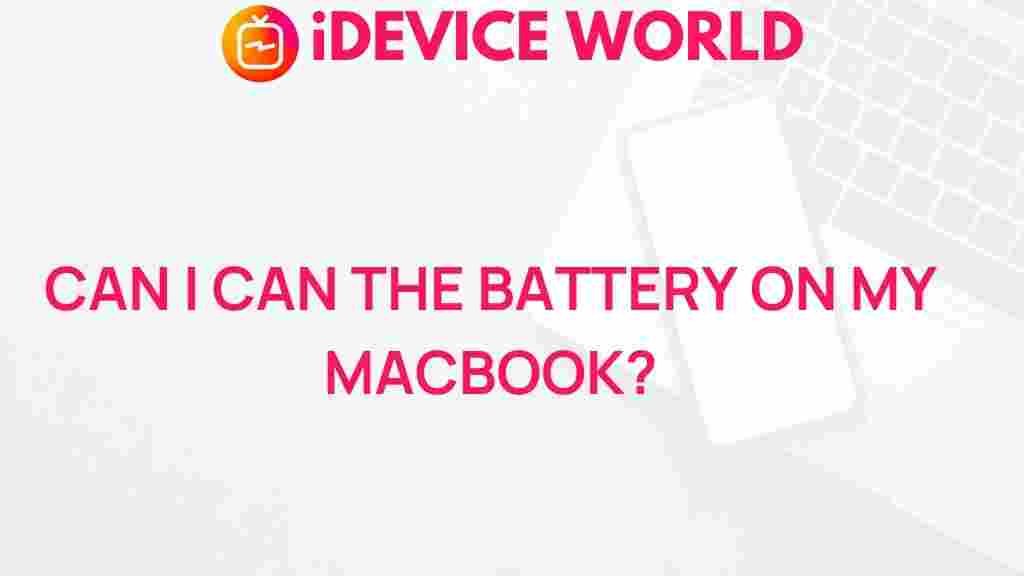Unleashing the Power: Can You Tweak Your MacBook Battery?
The MacBook has become synonymous with performance, portability, and innovation. As users of these sleek devices, we often find ourselves asking how to get the most out of our MacBooks, especially when it comes to battery life. With the right techniques, you can enhance your MacBook’s battery performance, prolong its lifespan, and ensure that you can rely on it for all your tasks. This article will explore various methods to tweak your MacBook battery, offering valuable insights and practical tips.
Understanding Your MacBook Battery
Before diving into the tweaks, it’s crucial to understand how your MacBook battery works. Most modern MacBooks use lithium-ion batteries, known for their efficiency and longevity. However, they do require specific care to maintain their health over time. Key factors include:
- Charge Cycles: A charge cycle is counted when you use 100% of your battery’s capacity, but this doesn’t mean you need to drain it completely. Frequent small charges can count towards a cycle.
- Battery Health: The health of your MacBook’s battery can degrade over time. You can check this in the System Preferences under the Battery settings.
- Temperature: Extreme temperatures can affect battery performance. Keeping your MacBook in a temperature-controlled environment is essential.
Step-by-Step Process to Optimize Your MacBook Battery
To unleash the full potential of your MacBook battery, follow these step-by-step methods:
1. Adjust Display Settings
Your MacBook’s display is one of the most power-hungry components. To conserve battery life:
- Lower the screen brightness by using the F1 and F2 keys.
- Enable “Automatically adjust brightness” in System Preferences under Displays.
- Consider using Dark Mode, which can reduce energy consumption on OLED screens.
2. Manage Energy Settings
Your MacBook comes with built-in energy-saving options:
- Navigate to System Preferences and select “Battery.”
- Enable “Battery Health Management” to optimize your battery’s longevity.
- Set the display to turn off after a short period of inactivity.
3. Limit Background Applications
Background applications can drain your battery without you realizing it. To manage this:
- Open “Activity Monitor” from the Utilities folder.
- Look for applications consuming excessive energy and close them when not in use.
- Limit applications that run at startup by going to System Preferences > Users & Groups > Login Items.
4. Use Safari for Browsing
Safari is optimized for MacBook and generally uses less energy than other browsers:
- Switch to Safari for web browsing to maximize battery efficiency.
- Close unnecessary tabs, as each one consumes resources.
5. Disable Unused Features
Features like Bluetooth and Wi-Fi can drain your battery if left on unnecessarily:
- Turn off Bluetooth when not in use by clicking the Bluetooth icon in the menu bar.
- Disable location services for applications that don’t require it by going to System Preferences > Security & Privacy.
6. Update macOS Regularly
Keeping your operating system updated is vital for battery performance:
- Updates often include optimizations for battery life.
- Go to System Preferences > Software Update to check for updates.
Troubleshooting Tips for MacBook Battery Issues
Sometimes, despite best efforts, you may encounter issues with your MacBook battery. Here are troubleshooting tips to help you address common problems:
1. Check Battery Health
If you notice your MacBook battery draining quickly, check its health:
- Click the Apple menu and select “About This Mac.”
- Click “System Report” and then select “Power” to view battery condition.
2. Reset SMC (System Management Controller)
Resetting the SMC can resolve various battery-related issues:
- Shut down your MacBook.
- For MacBooks with the T2 chip, press and hold the right Shift, left Option, and left Control keys for 7 seconds, then press and hold the power button for another 7 seconds.
- For other MacBooks, press and hold the Shift, Control, Option keys, and the power button simultaneously for 10 seconds.
3. Monitor Battery Usage
Use the Battery Preferences to identify apps that are consuming too much power:
- In the Battery section of System Preferences, you can see which apps are using the most energy.
- Consider uninstalling or replacing high-drain apps with lighter alternatives.
Additional Resources
For further reading on optimizing your MacBook’s performance, check out the official Apple support page. They provide detailed guides on maintaining your MacBook and troubleshooting various issues.
Conclusion
Maximizing your MacBook battery’s potential is entirely possible with a few thoughtful adjustments. By understanding the intricacies of your device, regularly managing settings, and following troubleshooting tips, you can significantly enhance battery life and performance. Remember, a well-maintained MacBook not only serves you better but also extends its longevity, allowing you to enjoy all the features it has to offer. Don’t hesitate to implement these strategies today to unleash the full power of your MacBook!
For a deeper dive into battery management techniques and software recommendations, feel free to visit our resource page.
This article is in the category Guides & Tutorials and created by iDeciveWorld Team
